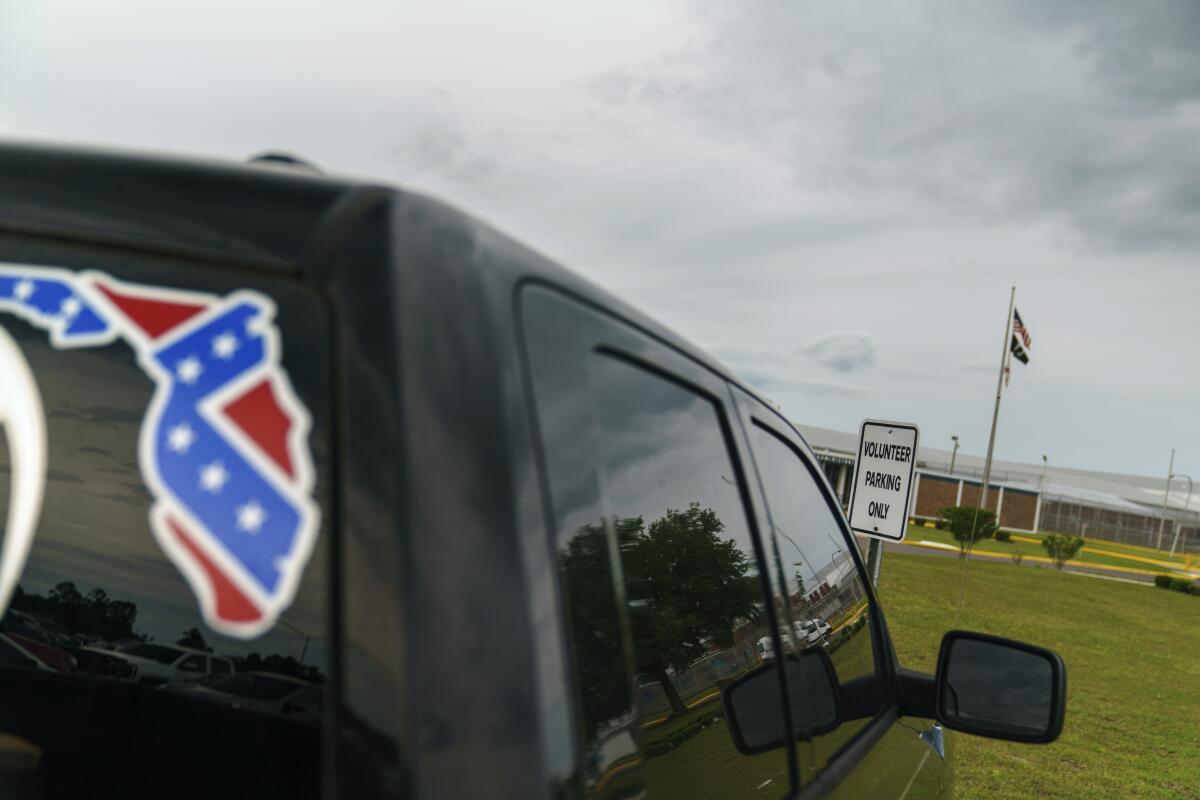White supremacist prison guards work with impunity in Florida

- Share via
In June, three Florida prison guards who boasted of being white supremacists beat, pepper-sprayed and used a stun gun on an inmate who screamed “I can’t breathe” at a prison near the Alabama border, according to a fellow inmate who reported it to the state.
The next day, the officers at Jackson Correctional Institution did it again to another inmate, the report filed with the Florida Department of Corrections’ Office of Inspector General stated.
“If you notice these two incidents were people of color. They [the guards] let it be known they are white supremacist,” the inmate, Jamaal Reynolds, wrote. “The Black officers and white officers don’t even mingle with each other. Every day they create a hostile environment trying to provoke us so they can have a reason to put their hands on us.”
Both incidents occurred in view of surveillance cameras, he said. Reynolds’ neatly printed letter included the exact times and locations and named the officers and inmates. It’s the type of specific information that would have made it easier for officials to determine whether the reports were legitimate. But the inspector general’s office did not investigate, corrections spokeswoman Molly Best said. Best did not provide further explanation, and the department hasn’t responded to the Associated Press’ August public records requests for the videos.
The acquittal of Kyle Rittenhouse is a reminder that the nation’s pathway through its wrenching debate over race, policing and identity is neither straight, clear nor short.
Some Florida prison guards openly tout associations with white supremacist groups to intimidate inmates and Black colleagues, a persistent practice that often goes unpunished, according to allegations in public documents and interviews with a dozen inmates and current and former employees in the nation’s third-largest prison system. Corrections officials regularly receive reports about guards’ membership in the Ku Klux Klan and criminal gangs, according to former prison inspectors and current and former officers.
Still, few such cases are thoroughly investigated by state prison inspectors; many are downplayed by officers charged with policing their own or discarded as too complicated to pursue.
“I’ve visited more than 50 [prison] facilities and have seen that this is a pervasive problem that is not going away,” said Democratic Florida state Rep. Dianne Hart. “It’s partly due to our political climate. But, those who work in our prisons don’t seem to fear people knowing that they’re white supremacists.”
The people the AP talked to, who live and work inside Florida’s prison system, describe it as chronically understaffed and nearly out of control. In 2017, three current and former Florida guards who were Ku Klux Klan members were convicted after the FBI caught them planning a Black former inmate’s murder.
This summer, one guard allowed 20 to 30 members of a white supremacist inmate group to meet openly inside a Florida prison. A Black officer happened upon the meeting, they told the AP, and later confronted the colleague who allowed it. The officer said their incident report about the meeting went nowhere, and the guard who allowed it was not punished.
The officer spoke on the condition of anonymity because they were not cleared to discuss official prison business. They told the AP that, after the report went nowhere, they did not feel safe at work and are seeking to leave.
Officers who want to blow the whistle on colleagues are often ostracized and labeled a “snitch,” according to current and former officers.
Mark Caruso, a former sergeant with Florida corrections who was twice fired and reinstated after blowing the whistle on fellow officers, described the department as a “good old boy” network.
He said that senior officers have the power to censor any allegations of corrupt behavior that occurs on their watch. This keeps reports inside prison walls.
Caruso worked at three prisons in central Florida and reported inmate beatings and officer misconduct multiple times. Being a whistleblower did not work out well for him. He was fired after reporting on a colleague at the first prison where he worked as a sergeant, he said.
He was reinstated after the officers’ union challenged the firing, and he moved to a new prison. There, he again reported an officer’s use of force and was later fired and reinstated after the union challenged it again.
In 2019, he reported for duty at another new post, the Central Florida Reception Center. He was soon greeted with signs on an employee bulletin board where his name had been crossed out and “SNITCH” scrawled instead, according to testimony at a union grievance hearing. Another officer spit on his car windshield, he said.
Despite the intimidation, Caruso continued reporting inmate abuse and other illegal activity by fellow officers.
“I have reported people when physically seeing them abuse inmates,” he testified in another grievance hearing this year. The AP obtained video of the hearing at which multiple officers and leadership testified in detail about the system’s reporting structure and culture.
Corrections officers are required to file “incident reports” if they see a co-worker acting inappropriately. In some Florida prisons, supervisors often tell them not to email the reports, according to officers who testified at Caruso’s hearing. Instead, they’re told to tell their supervisor verbally what happened or write it longhand. A superior officer then types it up, choosing the language and framing the event.
A sergeant testified that the reason he typed up his officers’ incident reports was because most struggle with writing. Also, most do not have computer access at the prison.
Caruso said he refused to report incidents of corruption verbally because it left no record, and he worried that prison leadership would censor his reports. So he emailed them to create an electronic record, a decision that, he says, irked prison leadership.
After seeing his reports go nowhere, he finally went over his superior officers’ heads. Caruso made contact with an investigator in the Office of Inspector General and emailed Florida Corrections Secretary Mark Inch directly. Inch responded to him expressing concern, Caruso said, and referred the matter to the inspector general’s office. That did not end well, either.
“For at least two years I reported to [the inspector general’s office] all of the corruption I saw. He didn’t respond or follow up,” Caruso said of the inspector general’s investigator.
Caruso was eventually fired again after officials said he’d failed to report an inmate beating — one Caruso said he did not actually witness. It was a baffling charge given his active campaign of reporting others throughout his corrections career. He claimed, unsuccessfully this time, that the firing was retaliation.
If the inspector general were motivated to aggressively investigate reports of abuse by white supremacists or other gang members working as correctional officers he would face barriers, the former investigators told the AP.
That’s because state law limits the use of inmates as confidential informants, they said, and guards are reluctant or afraid to snitch on their colleagues.
For an inmate to act as an informant, the FBI would have to take over the case because Florida law limits the inspector general’s office’s interactions with inmates, the former investigators said. “We don’t have the authority to do anything,” one said.
Officers, meantime, fear retaliation.
“Officers are saying their colleagues are members, but they can have me killed,” one former investigator said.
After the three guards in Florida were captured on FBI recordings plotting a Black inmate’s murder upon his release, Florida corrections spokeswoman Michelle Glady insisted there was no indication of a wider problem of white supremacists working in the prisons, so the state would not investigate further.
After the statement, an AP reporter in April visited the employee parking lot of one facility in the state’s rural north and photographed cars and trucks adorned with symbols and stickers that are often associated with the white supremacist movement: Confederate flags, Q-Anon and Thin Blue Line images.
Florida has grappled with this issue for decades. In the early 2000s, the corrections department was forced by a St. Petersburg Times expose to investigate a clique of racist guards who carried rope keychains with a noose. The newspaper reported that the noose keychains were used to signal a racist officer who was willing to inflict pain, particularly on Black inmates.
The state investigated the keychains and complaints from Black guards of workplace discrimination. Department inspectors interviewed the white guards who were known to carry the noose keychains and eventually cleared them all.
“This is a pattern all over the country,” said Paul Wright, a former inmate who co-founded the prisoner-rights publication Prison Legal News. Wright helped expose Ku Klux Klan members working in a Washington state prison in the 1990s. He and Prison Legal News have since reported cases of Nazis and Klan members working as correctional officers in California, New York, Texas, Illinois and many other states.
“There’s an institutional acceptance of this type of racism,” Wright said. “What’s striking about this is that so many of them keep their jobs.”
Most state prisons and police departments throughout the U.S. do very little background checking to see if new hires have extremist views, said Greg Ehrie, former chief of the FBI’s New York domestic terrorism squad, who now works with the Anti-Defamation League.
“There are 513 police agencies in New Jersey, and not one bans being part of outlaw motorcycle gangs. A prison guard who is the patched member of the Pagans, he can be out about it and tell you about it [with no punishment] because it’s not stipulated in the employment contract,” Ehrie said. The ADL lists the Pagans among biker gangs with white supremacist group affiliations.
This dynamic can lead to what the former Florida prison investigator described as “criminals watching over criminals.”
“If you have a heartbeat, a GED and no felony conviction, you can get a job. That’s sad,” said Caruso, the former Florida correctional sergeant.
Florida state Rep. Hart and Caruso have called for a thorough investigation of the issue and a federal takeover of the prison system.
The FBI said it would neither confirm nor deny if such an investigation had been launched, but Ehrie said it is likely.
“I would be extremely surprised if this wasn’t an open bureau investigation,” he said of Florida’s prison system. “It’s almost impossible that they’re not investigating.”
Meanwhile, reports of racist behavior by correctional officers continue, according to inmates and current and former Florida corrections employees.
In late September, at another Panhandle prison, a 25-year-old Black inmate reported being beaten by a white officer who said, “You’re lucky I didn’t have my spray on me, cuz I would gas yo Black ass.” The inmate’s lip was split open and his face swollen.
The inmate’s family requested anonymity for fear of retaliation.
His mother reported the incident to the inspector general’s office on Oct. 1 and requested a wellness check on him. The office sent an investigator to the facility to interview her son, according to emails provided by the family.
After the interview, the inspector general refused to investigate the officer’s conduct. The mother was told it was her son’s word versus the officer’s, and there was nothing they could do. The inspector general’s office referred the matter instead to the prison warden.
The officer continued working in the inmate’s dorm and threatened him, the inmate said in letters home.
“All them is a click, a gang. Ya feel me, they all work together,” the inmate wrote in October. For weeks, he sent desperate letters saying he was still being terrorized. He urged his mother to continue fighting.
“Don’t let up Mom. This has extremely messed up my mental. Got me shell shock, feel less of a man, violated ya feel me? But I love you.”
She eventually helped him get transferred in early November to a facility with a reputation for being even more lawless and brutal, according to the family and a current officer. He is four years into a 12-year sentence for attempted robbery with a gun or deadly weapon.
“I do look forward to seeing my son one day and I can only pray,” the mother told the AP. “I’m overwhelmed, tired and doing my best to hold on for my son’s sake.”
AP writer Michael Balsamo contributed to this report.
More to Read
Sign up for Essential California
The most important California stories and recommendations in your inbox every morning.
You may occasionally receive promotional content from the Los Angeles Times.











